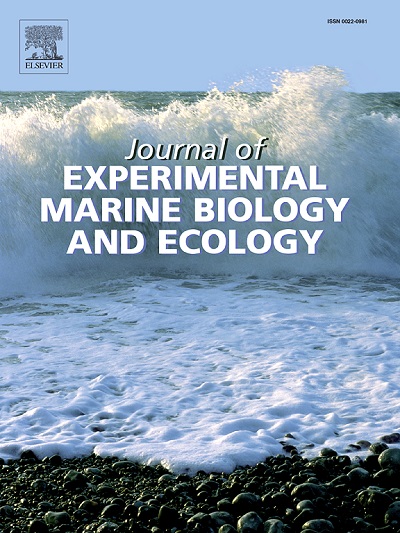表征被忽视的地中海生态系统工程师的抗氧化防御和能量代谢代理:沙贝拉(Leuckart, 1849)
IF 1.8
3区 生物学
Q3 ECOLOGY
Journal of Experimental Marine Biology and Ecology
Pub Date : 2025-09-22
DOI:10.1016/j.jembe.2025.152135
引用次数: 0
摘要
沿海环境是生产力很高的系统,通常面临巨大的人为压力。珊瑚虫(环节动物)珊瑚礁生态系统在沿海环境中发挥着至关重要的作用,提供必要的栖息地,维持生物多样性,减轻侵蚀,从而传递有价值的生态系统服务。尽管它们具有重要的生态意义,但对这些定居生物及其生理状态的研究很少,这代表了评估生态系统健康和恢复力的真正差距。本研究旨在通过研究造礁多毛体Sabellaria spinulosa中抗氧化防御机制和能量代谢的大小相关变化,提供有价值的基线数据(Leuckart, 1849)。在为期两年的春季实地调查中,从生长在意大利亚得里亚海北部沿岸(地中海)的单板型生物建筑中收集标本。我们分析了不同大小棘棘成虫标本的关键酶生物标志物。体型小的个体抗氧化酶(CAT、GPx、SOD、GSR和GST)和丙酮酸激酶(PK)活性较高。相反,较大的标本表现出较高的磷酸果糖激酶(PFK)活性,表明代谢可能更倾向于能量储存和应激恢复。观察到的酶模式的一致性跨越两个采样年突出了强健的,大小依赖的生理差异在棘棘。通过建立这一清晰的生理基线,我们的发现强调了该物种作为环境监测哨兵的适用性。其广泛的分布允许进行大规模的比较评估,而其生态耐受性可以检测亚致死应激反应,这对早期预警生物监测计划至关重要。本文章由计算机程序翻译,如有差异,请以英文原文为准。
Characterizing antioxidant defense and energy metabolism proxies in a neglected Mediterranean ecosystem engineer: Sabellaria spinulosa (Leuckart, 1849)
Littoral environments are highly productive systems that commonly face intense anthropogenic pressures. Polychaete sabellariid (Annelida) reef ecosystems play crucial roles in coastal environments by providing essential habitat, sustaining biodiversity, mitigating erosion and, thus, conveying valuable ecosystem services. Despite their ecological importance, these sedentary organisms and their physiological state are poorly studied, representing a real gap for assessing ecosystem health and resilience. This study aims at providing valuable baseline data by investigating size-related variations in antioxidant defense mechanisms and energy metabolism in the reef-building polychaete Sabellaria spinulosa (Leuckart, 1849). Specimens were collected from veneer-type bioconstructions growing along the northern Adriatic coast of Italy (Mediterranean Sea) during spring seasons in a two-year field survey. We analyzed key enzymatic biomarkers in adult specimens of S. spinulosa characterized by different sizes. Small-size individuals displayed higher activities of antioxidant enzymes (CAT, GPx, SOD, GSR, and GST) and pyruvate kinase (PK). Conversely, larger specimens exhibited elevated phosphofructokinase (PFK) activity, indicating a metabolism probably more prone to energy storage and stress resilience. The consistency of the observed enzymatic patterns across two sampling years highlights robust, size-dependent physiological differences in S. spinulosa. By establishing this clear physiological baseline, our findings underscore the suitability of this species as a sentinel for environmental monitoring. Its widespread distribution allows for large-scale comparative assessments, while its ecological tolerance enables the detection of the sub-lethal stress responses that are crucial for early-warning biomonitoring programs.
求助全文
通过发布文献求助,成功后即可免费获取论文全文。
去求助
来源期刊
CiteScore
4.30
自引率
0.00%
发文量
98
审稿时长
14 weeks
期刊介绍:
The Journal of Experimental Marine Biology and Ecology provides a forum for experimental ecological research on marine organisms in relation to their environment. Topic areas include studies that focus on biochemistry, physiology, behavior, genetics, and ecological theory. The main emphasis of the Journal lies in hypothesis driven experimental work, both from the laboratory and the field. Natural experiments or descriptive studies that elucidate fundamental ecological processes are welcome. Submissions should have a broad ecological framework beyond the specific study organism or geographic region.
Short communications that highlight emerging issues and exciting discoveries within five printed pages will receive a rapid turnaround. Papers describing important new analytical, computational, experimental and theoretical techniques and methods are encouraged and will be highlighted as Methodological Advances. We welcome proposals for Review Papers synthesizing a specific field within marine ecology. Finally, the journal aims to publish Special Issues at regular intervals synthesizing a particular field of marine science. All printed papers undergo a peer review process before being accepted and will receive a first decision within three months.

 求助内容:
求助内容: 应助结果提醒方式:
应助结果提醒方式:


